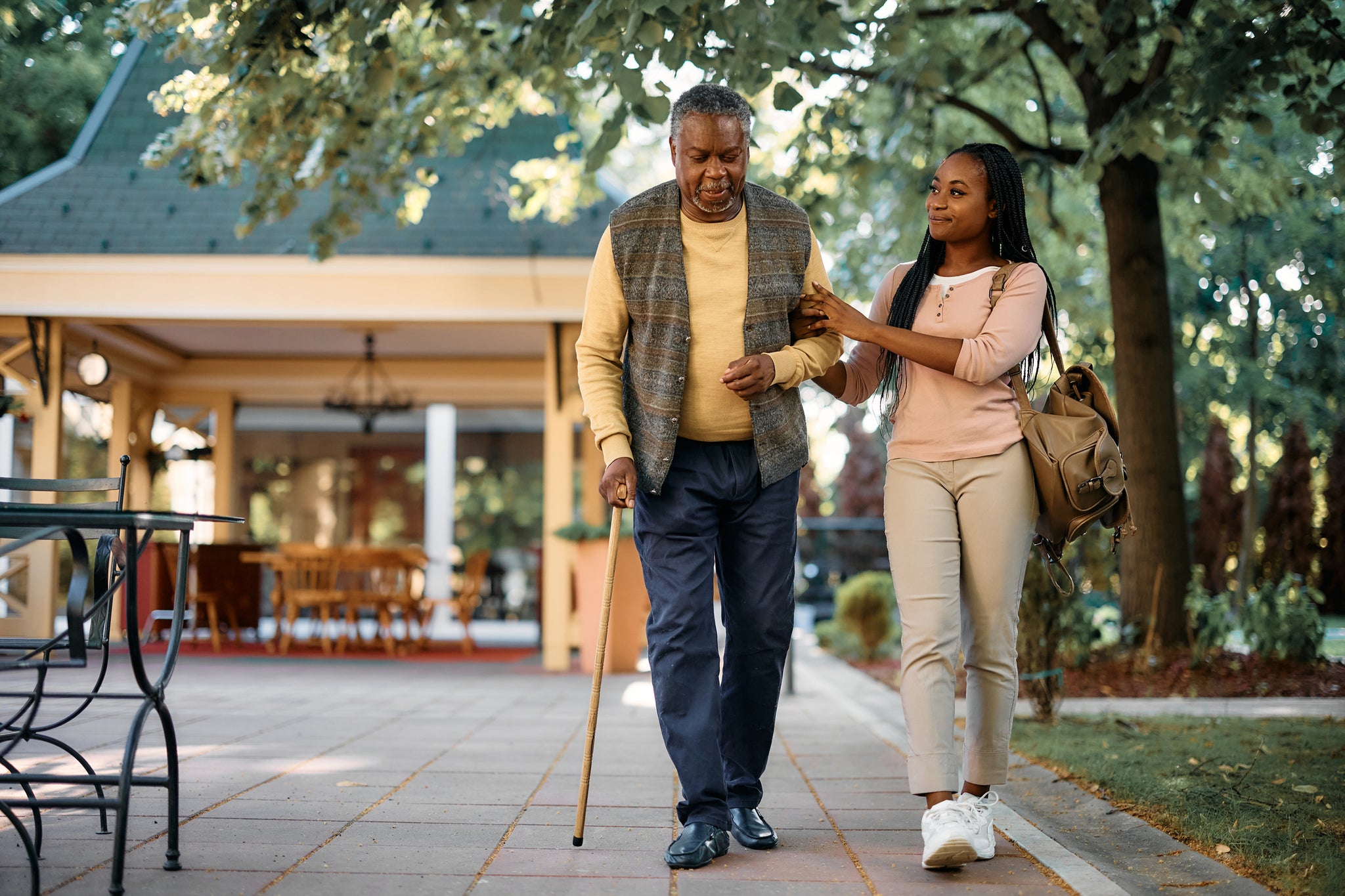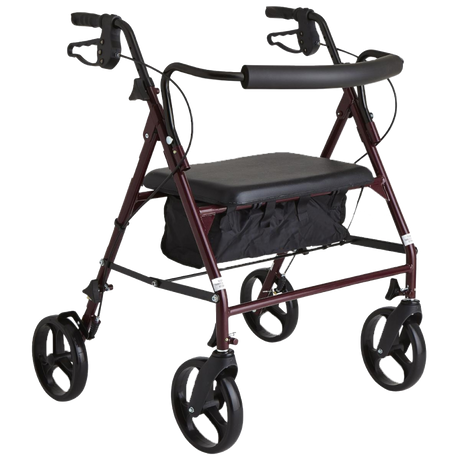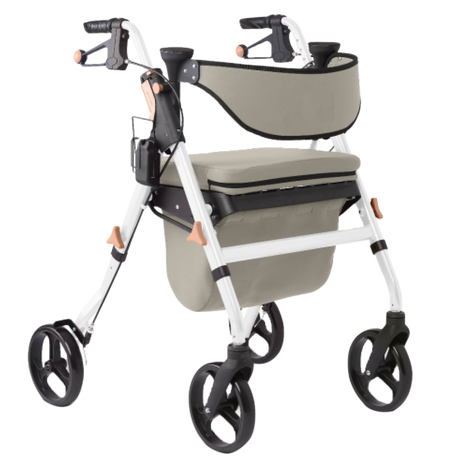Mobility issues are the leading cause of disability among older adults in America. Stiff and painful joints, age-related loss of muscle tone, and infrequent physical activity can lead to walking abnormalities and balance issues, putting seniors at an increased risk for falls. One person over the age of 65 in the U.S. suffers a fall accident every second.
The good news is that the right mobility aid can lower the likelihood of falls and allow seniors to perform their daily activities safely. Canes are a popular option and ideal for many seniors who need assistance maintaining balance or experience muscle weakness or pain on one side.
In this blog, we will provide practical guidance on walking with a cane safely. Whether you are using a cane for mobility assistance due to injury, aging, or a medical condition, mastering proper techniques is crucial. Our aim is to offer clear and concise instructions to help individuals navigate various terrains and environments confidently, promoting independence and minimizing the risk of accidents.
How to Walk with a Cane Properly
Choose the Right Type of Cane
Choosing the right type of cane is a crucial step in ensuring optimal support and comfort. Different individuals have varying needs, and selecting the appropriate cane can significantly enhance mobility. Factors such as height, weight, and the specific level of assistance required should be considered when making this decision. Whether opting for a standard cane, also known as a single-point cane, quad cane, or seat cane, understanding the distinct features and benefits of each type is essential. By making an informed choice based on individual requirements, users can experience greater stability and confidence in their daily activities.
Choose a single-point cane if you are struggling with more minor balance issues and need a cane for additional balance support. Four point quad canes are the next step in stability. Choose this cane if you need additional support with your balance and stability. Finally, a seat cane offers a small resting area if you need to take breaks while walking. If you have a lot of trouble with balance or struggle with walking for even short periods of time, it might be time to consider a walker or a rollator instead.
Walkers are mobility devices that have four touch points and provide sturdy support and balance for short and medium distances. A rollator also has four touch points, but a rollator has two front wheels and two back wheels. A rollator provides mobility support over longer distances and can provide more “all-terrain” support. Walkers are better served for users who are limited weight bearing on one of their legs or need additional stability. The four stable points allow the user to press down on the handles to take weight off their legs. A rollator helps users who are able to bear their full weight on both legs, but need added stability in order to walk a little more quickly. Additionally, both walkers and rollators often come with a seat for users to use if they get tired while in use.
Adjust the Height
Properly adjusting the height of your cane is fundamental for its effectiveness and your overall comfort. Begin by standing upright with your shoes on, allowing your arms to naturally hang by your sides. The top of the cane should align with the crease of your wrist, maintaining a slight bend in your elbow. Most canes come with adjustable mechanisms, such as push-button or twist-lock systems, facilitating easy customization. Experiment with different heights to find the one that provides optimal support and balance. Ensuring the correct height not only enhances the cane's functionality but also reduces the risk of strain or discomfort during use.
Hold the Cane Correctly
Holding a cane correctly is essential for maximizing its support and stability. Start by gripping the handle with your dominant hand, ensuring a firm yet comfortable grasp. The elbow should be slightly bent, allowing for a natural and relaxed posture. For additional support, the non-dominant hand can be placed on the cane's shaft, providing balance and stability. Maintain an upright stance while walking, and swing the cane forward with each step in coordination with the opposite leg. Regularly reassess your grip and posture to ensure ongoing comfort and effectiveness. Mastering the proper technique for holding a cane contributes significantly to a safer and more confident walking experience.
Stand Upright
Maintaining an upright posture while walking with a cane is paramount for both comfort and safety. Standing tall promotes better balance and distributes your weight evenly, reducing the strain on your muscles and joints. When hunched over, the center of gravity shifts, making it more challenging to navigate obstacles and increasing the risk of stumbling. An upright stance not only enhances the cane's support but also allows for a more efficient and coordinated gait. Additionally, proper posture contributes to improved breathing and overall well-being. By prioritizing an upright position, individuals can optimize the benefits of using a cane, enhancing their mobility and minimizing the potential for pain or injuries.
Initiate Movement with the Stronger Leg
Initiating movement with the stronger leg when walking with a cane is a key strategy for promoting stability and control. By leading with the stronger leg, individuals capitalize on the leg's greater strength and coordination, allowing for a more controlled and balanced stride. This approach minimizes the risk of tripping or losing balance during each step. Additionally, starting the movement with the stronger leg facilitates a smoother walking rhythm and helps in adapting to various terrains. By consciously engaging the stronger leg first, cane users can optimize their mobility, enhance their overall walking experience, and reduce the likelihood of uneven weight distribution, ultimately contributing to a safer and more confident gait.
Follow a Three-Point Gate
Alternatively, the three-point gait is a walking technique commonly employed by individuals using a cane for support. In this method, the sequence involves the cane, followed by the weaker or affected leg, and finally the stronger leg. The process unfolds in a coordinated manner, providing a stable and secure walking pattern. As the cane is placed forward, it bears weight, offering support during the subsequent steps with the weaker leg and stronger leg. This sequential approach ensures a three-point contact with the ground at all times, promoting enhanced balance and reducing the risk of falls. The three-point gait is particularly beneficial for those with mobility challenges, offering a reliable method to navigate various surfaces with increased confidence and safety.
Distribute Your Weight Evenly
Distributing weight evenly while using a cane is a fundamental principle for maintaining stability and preventing unnecessary strain. Placing too much weight on the cane or relying excessively on one side can compromise balance and increase the risk of falls. By ensuring an even distribution of weight between the cane and both legs, individuals promote a more centered and controlled stance. This approach not only maximizes the support provided by the cane but also minimizes the impact on joints, reducing the potential for discomfort or fatigue. Whether navigating flat surfaces or uneven terrain, consciously distributing weight evenly contributes to a smoother and safer walking experience, reinforcing the overall effectiveness of using a cane for mobility assistance.
Take Small Steps
Taking small steps is a key aspect of walking with a cane safely and effectively. This approach allows for better control, especially when navigating through confined spaces or uneven surfaces. Small steps help maintain balance and reduce the risk of overextending, which could lead to instability. By adopting a deliberate and measured stride, individuals using a cane can enhance their overall stability and coordination. This is particularly crucial when dealing with obstacles or negotiating changes in elevation. Additionally, smaller steps facilitate a more controlled and comfortable walking rhythm, promoting confidence and minimizing the likelihood of tripping or stumbling. Emphasizing the importance of taking small steps reinforces the principles of cautious and deliberate movement while utilizing a cane for support.
Navigating Stairs with a Cane
Navigating stairs with a cane requires a methodical approach to ensure safety and confidence. When ascending stairs, it is advisable to lead with the stronger leg, followed by the cane and then the weaker leg. This sequence provides a stable and secure ascent, utilizing the strength of the stronger leg for each step. Conversely, when descending stairs, initiate the movement with the cane, followed by the weaker leg, and then the stronger leg. This strategy allows the cane to provide support and balance during the descent. Always maintain a firm grip on the handrail, if available, and proceed one step at a time. Taking each step deliberately and ensuring the cane is securely placed before transferring weight contributes to a secure stair-navigation technique. By following these guidelines, individuals can navigate stairs with a cane confidently and reduce the risk of accidents.

Going Up and Down Curbs with a Cane
Negotiating curbs with a cane requires a careful and deliberate approach to ensure a smooth transition and prevent tripping hazards. When approaching an upward curb, position the cane on the higher surface first, followed by stepping up with the stronger leg and then the weaker leg. This sequence provides stability and aids in lifting the body onto the curb. Conversely, when descending a curb, start with the weaker leg followed by the stronger leg, ensuring the cane is placed on the lower surface for support. Maintaining a controlled pace and confirming secure footing with the cane before fully committing to the step is crucial. By adhering to this method, individuals using a cane can navigate curbs safely, minimizing the risk of stumbling or imbalance during changes in elevation.

Sitting in a Chair with a Cane
Sitting down with a cane involves a thoughtful process to ensure a smooth and controlled descent. Begin by standing with the cane positioned securely in the hand opposite to the side where you'll be sitting. Locate a stable chair or surface and back up until you feel the chair against the back of your legs. Slowly lower yourself by bending at the hips and knees, maintaining a controlled pace. As you descend, the cane can provide additional support, and it's essential to ensure it remains firmly planted on the ground. Once seated, place the cane within easy reach for accessibility when standing up again. This methodical approach to sitting down with a cane promotes stability, reduces the risk of falls, and allows individuals to navigate the sitting process with confidence and comfort.

Tips for Walking with a Cane Safely and Comfortably
In this section, we'll delve into some extra valuable tips for walking safely. Whether you're using a cane for support due to injury, aging, or a medical condition, incorporating these tips into your walking routine can significantly contribute to a safer and more confident gait. From mastering proper posture and cane usage to navigating various terrains with caution, each tip aims to empower individuals with the knowledge needed to walk securely and maintain independence. Let's explore these practical guidelines to ensure that your walking experience is both comfortable and safe.
Practice on Various Terrains
Practicing walking with a cane on various terrains is a crucial aspect of honing mobility skills and building confidence. Different surfaces present unique challenges, and mastering the ability to navigate them ensures adaptability in real-world scenarios. Begin with flat and even surfaces to establish a solid foundation, then gradually progress to more challenging terrains such as gravel paths, uneven sidewalks, or inclined surfaces. This practice not only refines balance and coordination but also enhances the ability to handle unexpected obstacles. Regular exposure to diverse terrains prepares individuals for the complexities of everyday environments, fostering a greater sense of assurance and autonomy while walking with a cane.
Be Aware of Upcoming Obstacles
Maintaining awareness of upcoming obstacles is a paramount element in walking safely with a cane. Being attuned to the environment allows individuals to anticipate challenges and take proactive measures to navigate around them. Whether it's uneven surfaces, obstacles on the path, or changes in elevation, a vigilant approach ensures a timely response. Utilizing the cane to detect and assess the terrain ahead is a valuable practice, helping individuals to adjust their stride and balance accordingly. By staying alert to the surroundings, cane users can proactively address potential obstacles, reducing the risk of accidents and enhancing overall safety during their walking experience.
Strengthen Your Muscles with Mobility Exercises
Incorporating mobility exercises into your routine is instrumental in strengthening the muscles essential for safe and effective walking with a cane. Focus on exercises that target the legs, core, and balance, as these areas play a crucial role in stability. Activities such as leg lifts, squats, and calf raises can enhance muscle strength and coordination. Additionally, engaging in core-strengthening exercises, like planks and pelvic tilts, contributes to overall stability. Balance exercises, such as standing on one leg or using a balance board, further reinforce coordination. Stretching can also be a useful tool to help your joints and muscles remain loose and limber. Regular commitment to these mobility exercises not only strengthens the muscles but also improves proprioception and control, providing individuals with the physical foundation needed for a secure and confident walking experience with a cane.
Talk to your doctor about how you can get an appointment with a physical therapist specialized in mobility. A physical therapist can design a mobility program specifically tailored to your individual needs and capabilities.
Consult with Your Healthcare Provider for Advice
Before embarking on any mobility or walking routine with a cane, it is essential to consult with your healthcare provider for personalized advice. Your healthcare professional can assess your specific needs, consider any underlying health conditions, and provide tailored recommendations to ensure the exercises and walking techniques are suitable for your individual circumstances. This consultation is especially important if you have pre-existing medical conditions or are recovering from an injury. Make sure to tell your healthcare provider if you are experiencing any new aches or pains. Seeking guidance from your healthcare provider not only ensures the safety of your mobility practices but also allows for the incorporation of exercises and walking techniques that align with your health goals and overall well-being. Always prioritize your health and consult with your healthcare provider before initiating any new mobility routine.
Sources:
U.S. Census Bureau. (2014, Dec. 2). Census Bureau Reports Majority of STEM College Graduates Do Not Work in STEM Occupations. U.S. Census Bureau News. https://www.census.gov/newsroom/archives/2014-pr/cb14-218.html
Centers for Disease Control and Prevention. (2023, Mar. 24). Falls Are Leading Cause of Injury and Death in Older Americans. CDC - Injury Center. https://www.cdc.gov/injury/features/older-adult-falls/index.html
Faruqui SR, Jaeblon T. Ambulatory assistive devices in orthopaedics: uses and modifications. J Am Acad Orthop Surg. 2010 Jan;18(1):41-50. doi: 10.5435/00124635-201001000-00006. PMID: 20044491.
Arthritis Foundation. (n.d.). How to Choose the Right Cane. Arthritis Foundation. https://www.arthritis.org/health-wellness/healthy-living/managing-pain/joint-protection/how-to-choose-the-right-cane









